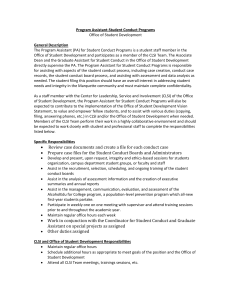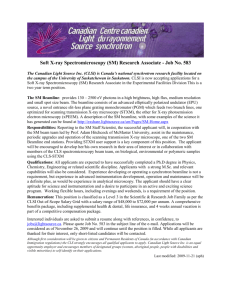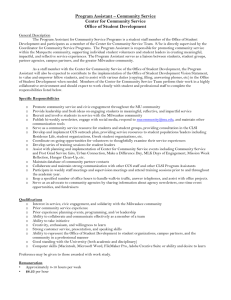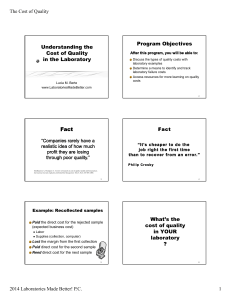POCT10-A2: Physician and Nonphysician Provider
advertisement
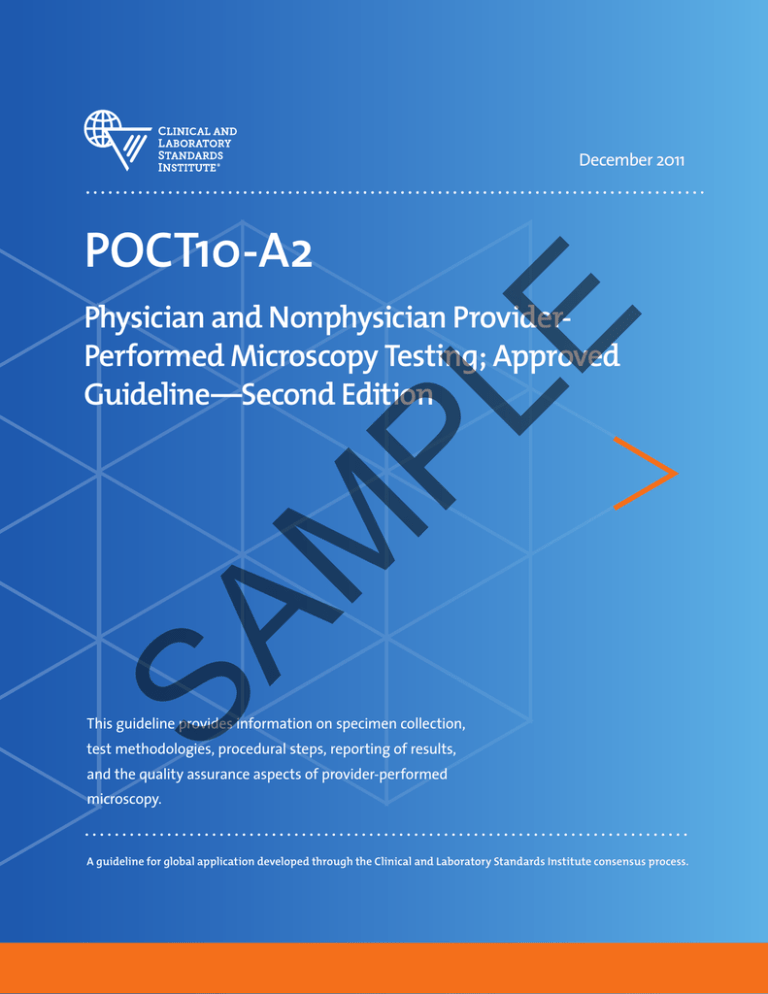
December 2011 POCT10-A2 SA M PL E Physician and Nonphysician ProviderPerformed Microscopy Testing; Approved Guideline—Second Edition This guideline provides information on specimen collection, test methodologies, procedural steps, reporting of results, and the quality assurance aspects of provider-performed microscopy. A guideline for global application developed through the Clinical and Laboratory Standards Institute consensus process. Clinical and Laboratory Standards Institute Setting the standard for quality in clinical laboratory testing around the world. The Clinical and Laboratory Standards Institute (CLSI) is a not-for-profit membership organization that brings together the varied perspectives and expertise of the worldwide laboratory community for the advancement of a common cause: to foster excellence in laboratory medicine by developing and implementing clinical laboratory standards and guidelines that help laboratories fulfill their responsibilities with efficiency, effectiveness, and global applicability. Consensus Process E Consensus—the substantial agreement by materially affected, competent, and interested parties—is core to the development of all CLSI documents. It does not always connote unanimous agreement, but does mean that the participants in the development of a consensus document have considered and resolved all relevant objections and accept the resulting agreement. PL Commenting on Documents CLSI documents undergo periodic evaluation and modification to keep pace with advancements in technologies, procedures, methods, and protocols affecting the laboratory or health care. CLSI’s consensus process depends on experts who volunteer to serve as contributing authors and/or as participants in the reviewing and commenting process. At the end of each comment period, the committee that developed the document is obligated to review all comments, respond in writing to all substantive comments, and revise the draft document as appropriate. Appeals Process M Comments on published CLSI documents are equally essential, and may be submitted by anyone, at any time, on any document. All comments are addressed according to the consensus process by a committee of experts. SA If it is believed that an objection has not been adequately addressed, the process for appeals is documented in the CLSI Administrative Procedures. All comments and responses submitted on draft and published documents are retained on file at CLSI and are available upon request. Get Involved—Volunteer! Do you use CLSI documents in your workplace? Do you see room for improvement? Would you like to get involved in the revision process? Or maybe you see a need to develop a new document for an emerging technology? CLSI wants to hear from you. We are always looking for volunteers. By donating your time and talents to improve the standards that affect your own work, you will play an active role in improving public health across the globe. For further information on committee participation or to submit comments, contact CLSI. Clinical and Laboratory Standards Institute 950 West Valley Road, Suite 2500 Wayne, PA 19087 USA P: 610.688.0100 F: 610.688.0700 www.clsi.org standard@clsi.org ISBN 1-56238-779-0 (Print) ISBN 1-56238-780-4 (Electronic) ISSN 1558-6502 (Print) ISSN 2162-2914 (Electronic) POCT10-A2 Vol. 31 No. 24 Replaces HS02-A Vol. 23 No. 5 Physician and Nonphysician Provider-Performed Microscopy Testing; Approved Guideline—Second Edition Abstract PL Mina L. Harkins, MBA, MT(ASCP) Peggy Mann, MS, MT(ASCP) Ginger A. Baker, MS, MT(AAB) Denise R. Eavers, MT(ASCP) Mohamed Hanafy, MBBch, MsC, MD Patricia L. Kraft, MA, MT(ASCP) Gregory Olsen, MT(ASCP)SBB C. Anne Pontius, MBA, CMPE, MT(ASCP) Ann E. Snyder, MT(ASCP) E Volume 31 Number 24 M Clinical and Laboratory Standards Institute document POCT10-A2—Physician and Nonphysician Provider-Performed Microscopy Testing; Approved Guideline—Second Edition provides information, instructions, and performance criteria to assist providers who perform microscopy procedures (provider-performed microscopy [PPM]), with accurate reporting of diagnostic information from their observations. SA These are appropriate procedures for the examining room, emergency room, or clinic environment as an adjunct to traditional clinical laboratory testing. This testing may also provide for a rapid diagnosis of the patient condition. The guideline relates information concerning specimen collection, methodologies, procedural steps, reporting of results, and the QA aspects of PPM. Clinical and Laboratory Standards Institute (CLSI). Physician and Nonphysician Provider-Performed Microscopy Testing; Approved Guideline—Second Edition. CLSI document POCT10-A2 (ISBN 1-56238-779-0 [Print]; ISBN 1-56238-780-4 [Electronic]). Clinical and Laboratory Standards Institute, 950 West Valley Road, Suite 2500, Wayne, Pennsylvania 19087 USA, 2011. The Clinical and Laboratory Standards Institute consensus process, which is the mechanism for moving a document through two or more levels of review by the health care community, is an ongoing process. Users should expect revised editions of any given document. Because rapid changes in technology may affect the procedures, methods, and protocols in a standard or guideline, users should replace outdated editions with the current editions of CLSI documents. Current editions are listed in the CLSI catalog and posted on our website at www.clsi.org. If your organization is not a member and would like to become one, and to request a copy of the catalog, contact us at: Telephone: 610.688.0100; Fax: 610.688.0700; E-Mail: customerservice@clsi.org; Website: www.clsi.org. Number 24 POCT10-A2 Copyright ©2011 Clinical and Laboratory Standards Institute. Except as stated below, any reproduction of content from a CLSI copyrighted standard, guideline, companion product, or other material requires express written consent from CLSI. All rights reserved. Interested parties may send permission requests to permissions@clsi.org. E CLSI hereby grants permission to each individual member or purchaser to make a single reproduction of this publication for use in its laboratory procedure manual at a single site. To request permission to use this publication in any other manner, e-mail permissions@clsi.org. Suggested Citation Proposed Guideline February 2000 Approved Guideline M February 2003 PL CLSI. Physician and Nonphysician Provider-Performed Microscopy Testing; Approved Guideline— Second Edition. CLSI document POCT10-A2. Wayne, PA: Clinical and Laboratory Standards Institute; 2011. Approved Guideline—Second Edition SA December 2011 ISBN 1-56238-779-0 (Print) ISBN 1-56238-780-4 (Electronic) ISSN 1558-6502 (Print) ISSN 2162-2914 (Electronic) ii Volume 31 POCT10-A2 Contents Abstract ....................................................................................................................................................i Committee Membership........................................................................................................................ iii Foreword ................................................................................................................................................ix 1 Scope .......................................................................................................................................... 1 2 Introduction ................................................................................................................................ 1 3 Safety ......................................................................................................................................... 2 4.1 4.2 4.3 5 A Note on Terminology ................................................................................................ 5 Definitions .................................................................................................................... 5 Abbreviations and Acronyms ....................................................................................... 7 Microscope................................................................................................................................. 7 5.1 5.2 5.3 6 PL Terminology............................................................................................................................... 5 Parts of the Microscope ................................................................................................ 8 Operation ....................................................................................................................10 Care of the Microscope ............................................................................................... 11 M 4 Standard Precautions..................................................................................................... 2 Personal Protective Equipment ..................................................................................... 2 Hand Hygiene ............................................................................................................... 3 Food, Drink, Cigarettes, and Cosmetics ....................................................................... 3 Workspace Cleaning and Disinfection.......................................................................... 3 Medical (Infectious, Biohazard) Waste Disposal ......................................................... 4 Chemical Safety ............................................................................................................ 4 E 3.1 3.2 3.3 3.4 3.5 3.6 3.7 Quality Assurance .................................................................................................................... 13 Microscopy Provider................................................................................................... 13 Equipment and Supply Management .......................................................................... 16 Patient Test Management............................................................................................ 17 Procedure Manual ....................................................................................................... 18 Quality Control ........................................................................................................... 19 Proficiency Testing ..................................................................................................... 20 Accreditation ............................................................................................................... 22 SA 6.1 6.2 6.3 6.4 6.5 6.6 6.7 7 Fecal Leukocyte Examinations (Also Known as Stool White Blood Cells) ............................ 23 7.1 7.2 7.3 7.4 7.5 7.6 7.7 8 Principle ...................................................................................................................... 23 Materials .....................................................................................................................23 Specimen Collection ................................................................................................... 24 Testing Procedure ....................................................................................................... 24 Quality Control ........................................................................................................... 25 Reporting Results ........................................................................................................ 25 Limitations of the Procedure ....................................................................................... 25 Fern Tests ................................................................................................................................. 25 8.1 8.2 8.3 8.4 8.5 Principle ...................................................................................................................... 25 Materials .....................................................................................................................26 Specimen Collection ................................................................................................... 26 Testing Procedure ....................................................................................................... 27 Quality Control ........................................................................................................... 27 v Number 24 POCT10-A2 Contents (Continued) 8.6 8.7 Nasal Smears for Inflammatory Cells (Also Known as “Nasal Smear for Eosinophils,” “Nasal White Blood Cells,” and “Nasal Smear for Granulocytes”) ........................................ 28 Pinworm Examinations ............................................................................................................ 30 10.1 10.2 10.3 10.4 10.5 10.6 10.7 11 Postcoital, Direct, Qualitative Examinations of Cervical Mucus ............................................ 34 11.1 11.2 11.3 11.4 11.5 11.6 11.7 Principle ...................................................................................................................... 34 Materials .....................................................................................................................34 Specimen Collection ................................................................................................... 34 Testing Procedure ....................................................................................................... 35 Quality Control ........................................................................................................... 35 Reporting Results ........................................................................................................ 36 Limitations of the Procedure ....................................................................................... 36 Qualitative Semen Analyses .................................................................................................... 36 SA 12 Principle ...................................................................................................................... 30 Materials .....................................................................................................................31 Specimen Collection ................................................................................................... 31 Testing Procedures ...................................................................................................... 32 Quality Control ........................................................................................................... 33 Reporting Results ........................................................................................................ 33 Limitations of the Procedure ....................................................................................... 33 PL 10 Principle ...................................................................................................................... 28 Materials .....................................................................................................................28 Specimen Collection ................................................................................................... 29 Testing Procedure ....................................................................................................... 29 Quality Control ........................................................................................................... 30 Reporting Results ........................................................................................................ 30 Limitations of the Procedure ....................................................................................... 30 E 9.1 9.2 9.3 9.4 9.5 9.6 9.7 M 9 Reporting Results ........................................................................................................ 27 Limitations of the Procedure ....................................................................................... 28 12.1 12.2 12.3 12.4 12.5 12.6 12.7 13 Urine Sediment Examinations ................................................................................................. 39 13.1 13.2 13.3 13.4 13.5 13.6 13.7 14 Principle ...................................................................................................................... 39 Materials .....................................................................................................................40 Specimen Collection ................................................................................................... 41 Testing Procedure ....................................................................................................... 42 Quality Control ........................................................................................................... 44 Reporting Results ........................................................................................................ 45 Limitations of the Procedure ....................................................................................... 46 Wet Mount Preparations and Potassium Hydroxide Preparations ........................................... 46 14.1 vi Principle ...................................................................................................................... 36 Materials .....................................................................................................................37 Specimen Collection ................................................................................................... 37 Testing Procedure ....................................................................................................... 37 Quality Control ........................................................................................................... 38 Reporting Results ........................................................................................................ 38 Limitations of the Procedure ....................................................................................... 39 Principle ...................................................................................................................... 46 Volume 31 POCT10-A2 Contents (Continued) 14.2 14.3 14.4 14.5 14.6 14.7 14.8 Materials .....................................................................................................................47 Specimen Collection ................................................................................................... 47 Testing Procedures ...................................................................................................... 49 Quality Control ........................................................................................................... 51 Reporting Results ........................................................................................................ 51 Limitations of the Procedure ....................................................................................... 52 Other Product Use in Potassium Hydroxide Microscopy ........................................... 53 References ............................................................................................................................................. 54 Appendix A. Microscopic Components in Urine Sediment.................................................................. 56 E Appendix B. Microscopic Components in Vaginal Fluid and Potassium Hydroxide Preparations, and Ectoparasites .................................................................................................................................. 76 Appendix C. List of Figures and Tables ............................................................................................... 85 The Quality Management System Approach ........................................................................................ 88 SA M PL Related CLSI Reference Materials ....................................................................................................... 89 vii Volume 31 POCT10-A2 Foreword Provider-performed microscopy (PPM) is a testing modality that requires the use of a microscope and is performed by physicians and/or nonphysician practitioners (referred to as “providers” in this guideline) at the time of the patient visit. Specimens used in PPM testing are considered labile or unstable after a very short period of time. PPM testing permits providers to render a rapid diagnosis that can, in turn, facilitate the rapid initiation of treatment. Historically, providers have used certain microscopic procedures to supplement their physical examinations in the diagnosis of patients. Unfortunately, not all providers are afforded adequate training time to fully comprehend good laboratory principles that ensure accurate results. Accurate results come from following standardized practices for the entire testing sequence, including preexamination (before testing), examination (performing the testing), and postexamination (test reporting). Preexamination Examination Postexamination PL • • • E The purpose of this guideline is to present critical aspects that contribute to accurate test results during the following testing phases: This document is not intended as a template for complying with specific federal laboratory laws, local laws, or accrediting organization requirements, but is intended to assist providers by presenting information that will increase the reliability and utility of microscopic testing done during the course of a patient visit. Specimen collection and handling Competence assessment Testing procedures and interpretation Proficiency testing QC QA Recommended documentation SA • • • • • • • M This document may be used as a key resource for those performing PPM procedures. Included in this document are topics selected to address certain characteristics of the diagnosis and management of patients in the clinical office setting. Also included are sections related to performance of laboratory testing, written with respect to performing testing in a setting outside the traditional laboratory: New to this document revision is a reorganized and more comprehensive section (Section 14) for wet preparations, which identifies differences between wet preparation for vaginal and nonvaginal procedures. Added to this document are representative pictures (or images) for as many procedures as possible, to facilitate training programs using this document as a teaching tool. Although considerable effort was made to ensure each test or procedure included in this guideline includes a picture (or image), in a few cases, none were available for citing. References were included to allow the audience to acquire this information. With the inclusion of these images, Appendix C has been created to help the reader identify and locate the images within the document. Key Words Examination, microscopy, postexamination, preexamination, provider ix Volume 31 POCT10-A2 Physician and Nonphysician Provider-Performed Microscopy Testing; Approved Guideline—Second Edition 1 Scope This guideline is limited to procedures that require the use of microscopic observation with minimum specimen preparation, typically performed by a provider in near-patient testing environments. This category of testing exists due to the nontransferable nature and labile nature of the specimens addressed in these testing processes. 2 Introduction PL E This guideline is intended for use in settings where near-patient testing is performed (including, but not limited to, hospitals, medical centers, academic centers, providers’ offices, outpatient clinics, community and rural health centers, and medical and dental training programs). Those performing provider-performed microscopy (PPM) procedures include physicians and nonphysician providers. Preparatory steps may be performed by trained support staff. This document may also be used to train qualified individuals who are allowed to perform PPM, as outlined by the local regulations; however, it may not address the application of specific rules, regulations, and accrediting organization requirements for PPM procedures. Local, state, and federal requirements and organizational sources should be consulted, as applicable. PPM, as carried out by trained providers, produces rapid, reliable results intended for use by the provider to immediately impact patient care decisions.a This type of testing requires that the performing individual be responsible for all aspects of the testing process, including: M Appropriate need for the test Acceptable patient preparation Proper specimen procurement and handling Positive patient/specimen identification Correct microscope selection, use, storage, and maintenance Supplies selection, use, and storage Test methodologies in a procedure manual Accurate interpretation of observed elements QA and competence assessment Documentation of results and QC activities SA • • • • • • • • • • The appropriate uses of the described procedures may include the following: • Examination of the fecal smear for leukocytes to suggest or exclude the diagnosis of a number of pathological conditions • In conjunction with patient history and vaginal fluid pH, examination of vaginal secretions to detect the presence of amniotic fluid, indicating rupture of the amniotic sac (known as fern tests) • Examination of the nasal smear for granulocytes to identify an allergic etiology for upper respiratory symptoms a In the United States, according to the Clinical Laboratory Improvement Amendments (CLIA), it is the designated laboratory director’s overall responsibility to ensure the accuracy and reliability of the testing performed. © Clinical and Laboratory Standards Institute. All rights reserved. 1 Number 24 POCT10-A2 Direct specimen examination from the perianal region to detect infestation by the Enterobius vermicularis parasite • Postcoital, direct, qualitative examinations of cervical mucus to investigate infertility • Qualitative examination of semen to confirm effective vasectomy or to investigate infertility • Urine sediment examination to identify the cause of symptomatic presentations or abnormal chemical dipstick results • Wet mount preparations to detect the presence of bacterial, fungal, or parasitic organisms, and other cellular elements indicative of pathological conditions • Potassium hydroxide (KOH) preparations to detect yeast, fungal elements, and ectoparasites 3 E • Safety Standard Precautions M 3.1 PL Because the anticipated location of PPM testing is in the environment of the medical office practice, emergency room, or clinic environment, written protocols may be required by regional regulatory bodiesb for employee safety. A safety manual (written or accessible online) with specific policies should be available where testing is located. Because these locations for direct patient care may be diverse and the provider may be the only one involved in the testing process, recognition should be made to provide safe work conditions that meet applicable regional requirements, determine appropriate personal protective equipment (PPE), and provide safe disposal of medical (infectious, biohazardous) waste. Testing supplies of a harmful or corrosive nature should be securely stored in areas where only medical personnel have access. SA Because it is often impossible to know what isolates or specimens might be infectious, all patient and laboratory specimens are treated as infectious and handled according to “standard precautions.” Standard precautions are guidelines that combine the major features of “universal precautions and body substance isolation” practices. Standard precautions cover the transmission of all known infectious agents and thus are more comprehensive than universal precautions, which are intended to apply only to transmission of blood-borne pathogens. Standard and universal precaution guidelines are available from the Centers for Disease Control and Prevention.1 For specific precautions for preventing the laboratory transmission of all known infectious agents from laboratory instruments and materials, and for recommendations for the management of exposure to all known infectious diseases, refer to CLSI document M29.2 3.2 Personal Protective Equipment PPE must be used as defined by the local, state, and federal regulations, and in the absence of such, PPE should be used in the following situations: • b When the performing provider’s duties involve occupational exposure, appropriate use of gloves, gowns, protective (impervious) laboratory coats or cover gowns, face shields or masks, and eye protection is recommended. In the United States, for example, the US Occupational Safety and Health Administration. 2 © Clinical and Laboratory Standards Institute. All rights reserved. Number 24 POCT10-A2 The Quality Management System Approach Clinical and Laboratory Standards Institute (CLSI) subscribes to a quality management system approach in the development of standards and guidelines, which facilitates project management; defines a document structure via a template; and provides a process to identify needed documents. The quality management system approach applies a core set of “quality system essentials” (QSEs), basic to any organization, to all operations in any health care service’s path of workflow (ie, operational aspects that define how a particular product or service is provided). The QSEs provide the framework for delivery of any type of product or service, serving as a manager’s guide. The QSEs are as follows: Organization Customer Focus Facilities and Safety Personnel Purchasing and Inventory Equipment Process Management Documents and Records Information Management Nonconforming Event Management Assessments Continual Improvement GP27 GP29 GP27 GP02 GP16 GP27 GP29 M29 Continual Improvement X GP02 Assessments E Nonconforming Event Management Information Management X Documents and Records Process Management X PL GP21 Equipment X Purchasing and Inventory Personnel Facilities and Safety Customer Focus Organization POCT10-A2 addresses the QSEs indicated by an “X.” For a description of the other documents listed in the grid, please refer to the Related CLSI Reference Materials section on the following page. M POCT08 Path of Workflow SA A path of workflow is the description of the necessary processes to deliver the particular product or service that the organization or entity provides. A laboratory path of workflow consists of the sequential processes: preexamination, examination, and postexamination and their respective sequential subprocesses. All laboratories follow these processes to deliver the laboratory’s services, namely quality laboratory information. POCT10-A2 addresses the clinical laboratory path of workflow processes indicated by an “X.” For a description of the other documents listed in the grid, please refer to the Related CLSI Reference Materials section on the following page. 88 GP16 © X GP16 X X Sample management Results reporting and archiving X GP16 Postexamination Interpretation Sample receipt/processing X GP16 Results review and follow-up Sample transport X GP16 Examination Examination Sample collection Examination ordering Preexamination Clinical and Laboratory Standards Institute. All rights reserved. Volume 31 POCT10-A2 Related CLSI Reference Materials∗ Laboratory Documents: Development and Control; Approved Guideline—Fifth Edition (2006). This document provides guidance on development, review, approval, management, and use of policy, process, and procedure documents in the medical laboratory community. GP16-A3 Urinalysis; Approved Guideline—Third Edition (2009). This document addresses procedures for testing urine, including materials and equipment; macroscopic/physical evaluation; chemical analysis; and microscopic analysis. GP21-A3 Training and Competence Assessment; Approved Guideline—Third Edition (2009). This document provides background information and recommended processes for the development of training and competence assessment programs that meet quality and regulatory objectives. GP27-A2 Using Proficiency Testing to Improve the Clinical Laboratory; Approved Guideline—Second Edition (2007). This guideline provides assistance to laboratories in using proficiency testing as a quality improvement tool. GP29-A2 Assessment of Laboratory Tests When Proficiency Testing Is Not Available; Approved Guideline— Second Edition (2008). This document offers methods to assess test performance when proficiency testing (PT) is not available; these methods include examples with statistical analyses. This document is intended for use by laboratory managers and testing personnel in traditional clinical laboratories as well as in point-of-care and bedside testing environments. M29-A3 Protection of Laboratory Workers From Occupationally Acquired Infections; Approved Guideline— Third Edition (2005). Based on US regulations, this document provides guidance on the risk of transmission of infectious agents by aerosols, droplets, blood, and body substances in a laboratory setting; specific precautions for preventing the laboratory transmission of microbial infection from laboratory instruments and materials; and recommendations for the management of exposure to infectious agents. POCT08-A Quality Practices in Noninstrumented Point-of-Care Testing: An Instructional Manual and Resources for Health Care Workers; Approved Guideline (2010). This instructional guideline delivers laboratory science concepts and activities with the goal of increasing knowledge and quality of laboratory testing for testing personnel with no laboratory background. SA M PL E GP02-A5 ∗ CLSI documents are continually reviewed and revised through the CLSI consensus process; therefore, readers should refer to the most current editions. © Clinical and Laboratory Standards Institute. All rights reserved. 89 PL As we continue to set the global standard for quality in laboratory testing, we’re adding initiatives to bring even more value to our members and customers. E Explore the Latest Offerings from CLSI! Power Forward with this Official Interactive Guide Fundamentals for implementing a quality management system in the clinical laboratory. The value of a CLSI membership begins with significant discounts— up to 70% off—on our trusted clinical laboratory standards and guidelines, but the benefits extend far beyond cost savings: Benefits to Industry Contribute to Standards that Streamline Product Review Processes Access a Deep Network of Customers, Peers, Regulators, and Industry Leaders Raise Your Organization’s Profile in the Clinical Laboratory Community Benefits to Laboratories Directly Influence CLSI Standards to Ensure they are Practical and Achievable Access Globally Recognized Standards for Accreditation Preparedness Help Drive Higher Levels of Patient Care Quality All Over the World Benefits to Government Aid in the Development of Consensus Standards that can Impact Legislation Connect with Over 2,000 Influential Organizations Across the Global Laboratory Community Help Laboratories Provide Safe and Effective Care of the Highest Quality and Value www.clsi.org/membership About CLSI M The Clinical and Laboratory Standards Institute Visit the CLSI U Education Center SA Where we provide the convenient and cost-effective education resources that laboratories need to put CLSI standards into practice, including webinars, workshops, and more. Shop Our Online Products e CLIPSE TM Ultimate Access Including eCLIPSE Ultimate Access™, CLSI’s cloud-based, online portal that makes it easy to access our standards and guidelines—anytime, anywhere. Introducing CLSI’s New Membership Opportunities (CLSI) is a not-for-profit membership organization that brings together the varied perspectives and expertise of the worldwide laboratory community for the advancement of a common cause: to foster excellence in laboratory medicine by developing and implementing clinical standards and guidelines 950 West Valley Road, Suite 2500, Wayne, PA 19087 P: 610.688.0100 Toll Free (US): 877.447.1888 F: 610.688.0700 E: membership@clsi.org that help laboratories fulfill their responsibilities with efficiency, effectiveness, and global applicability. More Options. More Benefits. More Value. Join in Our Mission to Improve Health Care Outcomes We’ve made it even easier for your organization to take full advantage of the standards resources and networking opportunities available through membership with CLSI. Find Membership Opportunities See the options that make it even easier for your organization to take full advantage of CLSI benefits and our unique membership value. For more information, visit www.clsi.org today. E PL M SA 950 West Valley Road, Suite 2500, Wayne, PA 19087 USA P: 610.688.0100 Toll Free (US): 877.447.1888 F: 610.688.0700 E: customerservice@clsi.org www.clsi.org PRINT ISBN 1-56238-779-0 ELECTRONIC ISBN 1-56238-780-4
